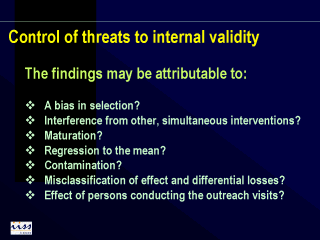| front |1 |2 |3 |4 |5 |6 |7 |8 |9 |10 |11 |12 |13 |14 |15 |16 |17 |18 |19 |review |
 |
A bias in selection: There were only differences in one variable (volume of prescriptions): Is this due to chance or is it real? Ultimately the effect of this difference did not affect the results of the study because there were no differences in the overall reduction of packages prescribed. Other, simultaneous interventions: The possible effect of this factor was minimized by limiting the intervention to a single month, and because no other specific interventions were conducted during the same period. Maturation: The fact that differences were observed between the groups minimizes the possibility of this bias. Regression to the mean: The potential effect of this bias was minimized with the use of the time series. Contamination: Contamination seems impossible because the intervention was very short, and because the centres are far apart. Misclassification of the effect and differential losses: The information system loses less than 4.5% of the prescriptions, making either of these biases very unlikely. Effect of the person conducting the outreach visit: This bias is highly improbable; the person did not participate in the systematic review, and was unaware of its results when giving the sessions to the placebo group. |